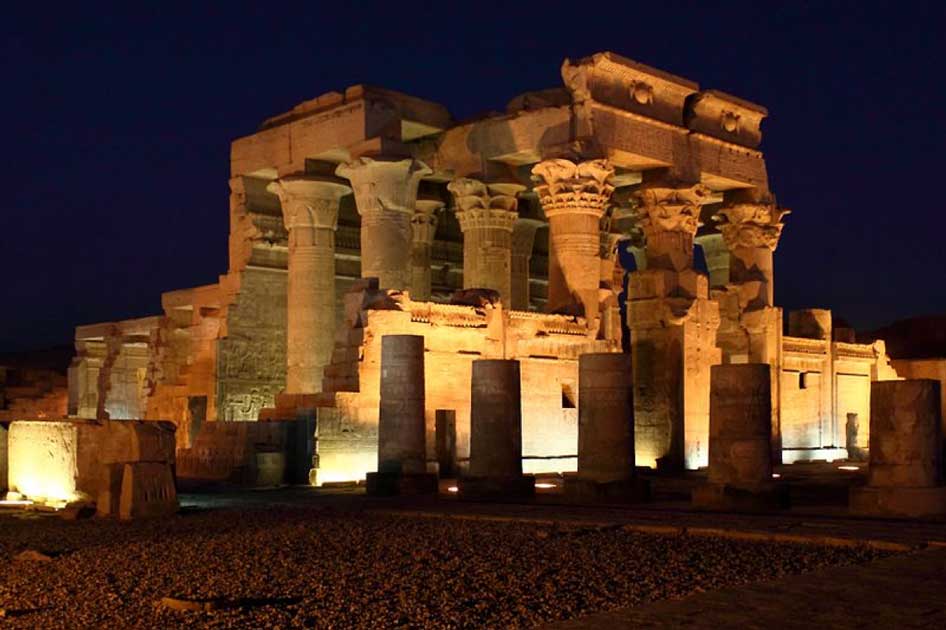Engraved Tablets Found at Kom Ombo Temple Reveal New Historic Trail to Horemheb
About 1289 BC Pharaoh Seti I became consecrated to the god Set and having founded the 19th dynasty he reigned for an estimated 55 years. Now, ancient carvings including ‘stone engravings and paintings’ have been found at Kom Ombo, a twin temple in southern Egypt, which are yielding new information about his relentless and highly-successful military campaigns in North Africa, and a lot more.
The Egyptian Ministry of Antiquities announced last week that their archaeologists had discovered the inscriptions while “conducting a groundwater-lowering project in Aswan” at the ‘twin’ or double temple at Kom Ombo. Situated about 30 miles (48 km) north of Aswan, Kom Ombo was built during the Graeco-Roman period between 332 BC and AD 395 and was dedicated to both the falcon-headed god Horus and a crocodile-headed god named Sobek, according to a report in Live Science.
An earlier temple at Kom Ombo
With its twin entrances, gateways and chapels, Kom Ombo was known to date back 2,300 years to the Ptolemaic Dynasty. But archaeologists believe that the recently found inscriptions may have originally been executed in “an earlier temple, now lost, at Kom Ombo” that was located on the same spot. Egyptologist Peter Brand, a professor of ancient history at the University of Memphis in Tennessee, told Live Science that one inscription depicts, “Seti I worshiping the gods Horus and a crocodile-headed god called Sobek and this is an exciting discovery and may be historically important.”

Image of Seti I, Sobek and Horus has been found at Kom Ombo. (Ministry of Antiquities)
Seti I is shown worshiping both Sobek and Horus, which Brand says:
“proves that the double cult of these two gods [Horus and Sobek] was already established at Kom Ombo in the 19th Dynasty of the New Kingdom period, more than 1,000 years [before] the later temple was built.”
Brand believes this was “a major royal inscription” containing data about the king's activities in the region, and “perhaps a dedication to the temple of Horus and Sobek [at] Kom Ombo.”
A second, larger inscription and image was discovered which belongs either to Seti I or to Ptolemy IV (expert opinions are not currently in agreement on which), while part of a third smaller inscription was found to have “yellow paint” despite the ravages of 3,300 years of passing time.

Large inscription could also be of Seti from the 19 th Dynasty. (Ministry of Antiquities)
Bringing 1000 years more history to the site
These inscriptions begin to make sense when we consider other images of Seti discovered at a site to the north of Kom Ombo called Gebel es-Silsilah. Brand suggests Seti was possibly “traveling through his realm in Year One [of his reign]” making stops at temples on his way south from Thebes (modern Luxor) and he added that "Seti came from a family of military generals, and after he became pharaoh, he launched military campaigns to conquer Libya, Canaan, Syria and Nubia."
- The Tomb of Pharaoh Seti I: A Missing Mummy, An Unexpected Tunnel and a Mummified Bull
- Omm Sety – A British Woman Whose Life Was Lined by Reincarnation and Connected to a Pharaoh
- Feminism and the Battle for Women’s Rights in Ancient Egypt

Inscription and image of Seti or Ptolemy with Horus. (Ministry of Antiquities).
Horemheb, the General King
According to an article about the discovery in Egypt Today, the inscriptions, including “drawings and hieroglyphs,” not only tell of Seti I and Ptolemy IV but most interestingly to archaeologists, one of the inscriptions mentions “a powerful general in King Tut's army.” Aidan Dodson, an Egyptology professor at the University of Bristol noticed that the larger inscription at Kom Ombo mentioned Pharaoh “Horemheb,” who ruled up to around 1293 BC (the last pharaoh of the 18 th Dynasty) and Dodson told Live Science that Horemheb “was in fact the highest general in King Tut's army during Tut's reign.”

Inscription under the Seti image mentions Horemheb. (Ministry of Antiquities)
With unknown parentage Horemheb is believed to have been a commoner who originated from Herakleopolis Magna (ancient Hnes, modern Ihnasya el-Medina ) on the west bank of the Nile near the entrance to the Fayum, evident in that his coronation text formally credits the God Horus of Hnes for establishing him on the throne. As commander in chief of the army under the reign of Tutankhamun and Ay, after his accession to the throne, Horemheb reformed the Egyptian state and took action against the preceding, troublesome and divisive, Amarna rulers. He not only demolished monuments of Akhenaten, reusing them in his own building projects, but he also toppled monuments of Tutankhamun and Ay.
With his tongue fixed firmly in his cheek, Ronald Leprohon, professor of Egyptology at the University of Toronto, told Live Science that Horemheb “became king by marrying into the royal family, and being head of the army probably also didn't hurt his chances of becoming pharaoh, either.”
Top image: Temple of Kom Ombo at dusk. Source: CC BY-SA 3.0
By Ashley Cowie



















